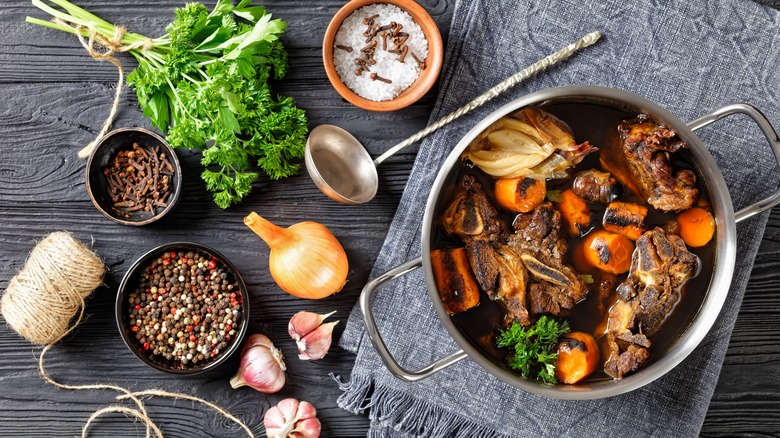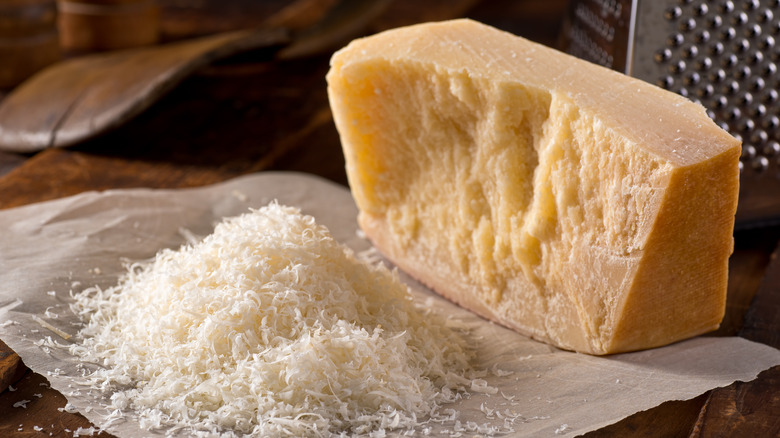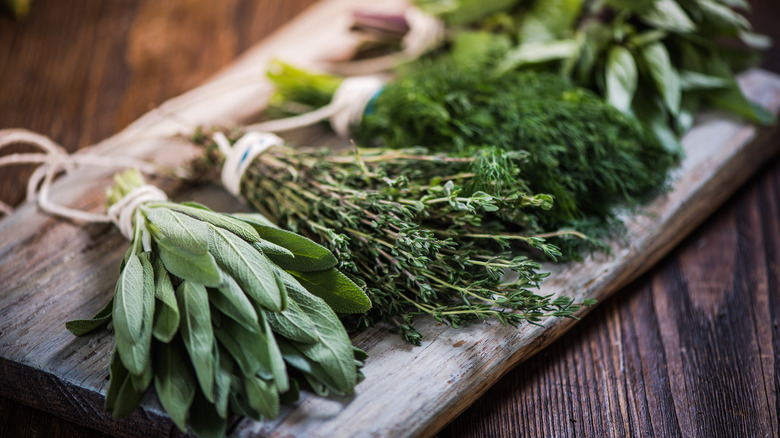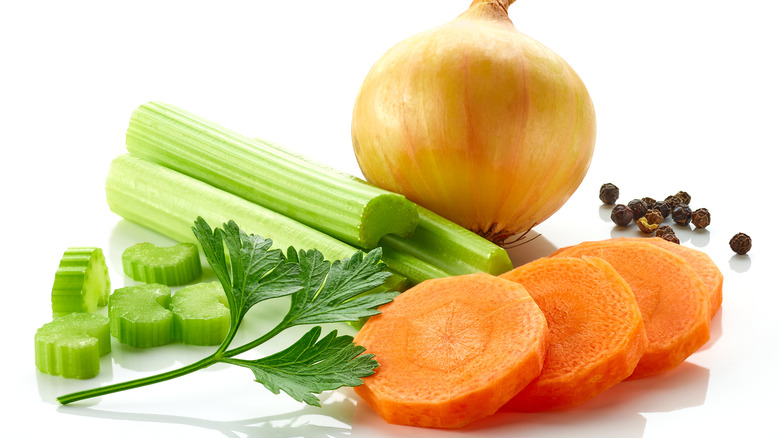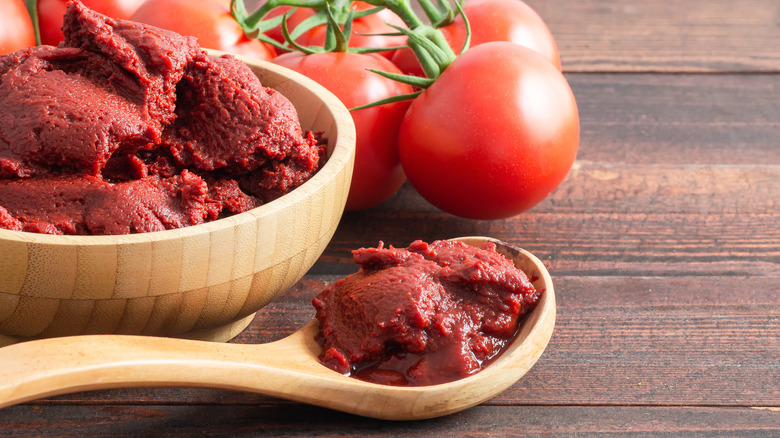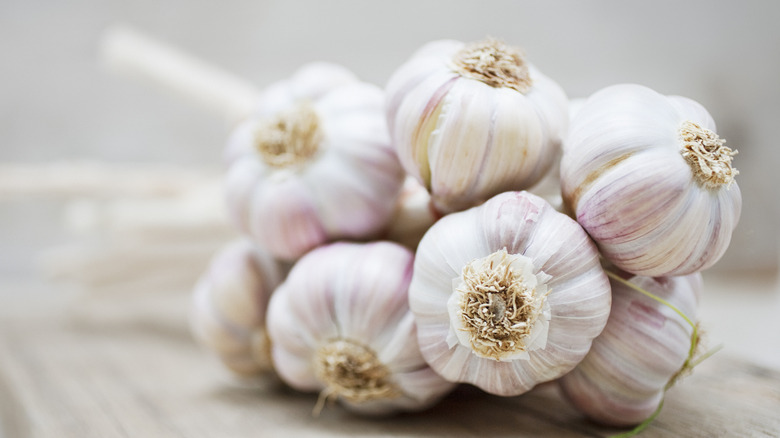7 Ingredients That Will Kick Boxed Broth And Stock Up A Notch
Homemade stock and broth can elevate anything from comforting soups to flavorful gravies, but sometimes, we just don't have the time to make them from scratch. Both ingredients take hours to make properly — stock is generally made by simmering bones, vegetables, and aromatics for 6 to 8 hours, and broth is made the same way, except that it uses meat instead of bones, according to Food & Wine.
Boxed stock comes to the rescue. There is nothing wrong with taking shortcuts in the kitchen, and boxed stock and broth are pantry staples for good reason. But boxed stock (or boxed broth) can be even better. You can give it a homemade flavor with the addition of a few items you likely already have in your kitchen and pantry. And, even better, if you already know which dish you plan to use the stock or broth in, you can add ingredients that are perfectly customized to the flavor profile you're trying to achieve.
Add umami with parmesan rinds
Parmesan rinds should never go to waste. Not only are they perfect for tossing into a pot of soup or a slow-simmered sauce for extra flavor, but they are ideal for giving boxed broth or stock deep, complex, homemade flavor. The rind is often the most flavorful part of parmesan cheese, with a pungent, salty, nutty flavor that elevates anything you add it to.
While parmesan rinds are a fantastic addition to any broth or stock, America's Test Kitchen notes that they're perfect for imparting a touch of umami to vegetable broths, which are often lacking in that particular flavor department.
Add your parmesan rinds to a saucepan, along with your boxed stock or broth of choice, and bring it to a slow simmer. The longer you can simmer it, the better, but if you can, give it at least 30 minutes to impart its flavor.
Fresh herbs for fresh flavor
If there's one thing that almost universally elevates cooking, it's the addition of herbs. This is equally true for kicking up a box of stock or broth.
Jamie Oliver advises that certain herbs are perfect for stocks and broths, because they have aromatic, flavorful profiles that won't be overwhelming. Chef Oliver recommends parsley, rosemary, and thyme. Other herbs, such as oregano or tarragon, while absolutely lovely, can be overpowering and make your entire dish taste of that single note if they're added to a long-simmering dish such as a stock.
No fresh herbs on hand? No problem — dried herbs work here as well, as long as you keep in mind that dried herbs are more concentrated in flavor than fresh herbs, so you'll want to pay attention to the ratio of dried herbs to fresh to add to your stock or broth. In general, you'll want to use a teaspoon of dried herbs to substitute for one tablespoon of fresh herbs.
As far as the quantity of herbs to add to stock or broth, most recipes simply call for "a bunch" of thyme, parsley, or rosemary. According to Food & Wine, "a bunch" translates to roughly 2 to 4 tablespoons, so, if you're using dried herbs, use 2 to 4 teaspoons per quart of stock or broth.
Deepen the flavor with fresh vegetables
A sure sign of a well-made broth or stock is the complexity of flavor. While one-note stocks and broths have their place, if you're making stock as a base for soups, stews, sauces, or gravies, depth of flavor is your friend. An easy way to get that depth is by adding fresh vegetables.
This is an easy tip that makes a big difference. Add your boxed stock or broth to a saucepan and bring it to a simmer. Raid your crisper drawer for flavorful veggies to add to the stock. Great options include carrots, celery, and garlic — all of which are aromatic and delicious, but won't overpower the stock or broth. For even more flavor (and a bit of color) take a page from Nigella Lawson's book and keep the outer onion skins on (via Good Housekeeping). You don't need to chop or dice them finely; just cut them small enough to fit into your pan.
As far as vegetables to avoid, you'll want to stay away from broccoli, brussels sprouts, and other cruciferous veggies, since they can overpower the flavor of the stock or broth. It's also a good idea to stay away from beets, which can dramatically change the color, and potatoes, which can make the broth or stock cloudy due to their starchiness (via MasterClass).
Tomato paste for color and richness
Another way to give boxed broth or stock a homemade, complex flavor is to add tomato paste. Tomato paste is a fantastic ingredient to have on hand in the pantry since it provides concentrated flavor in so many dishes. Add stock or broth to the list — tomato paste not only adds flavor and brightness to broth but a richer color as well.
To get an even more complex flavor, Food & Wine recommends caramelizing it first. To caramelize tomato paste, add olive oil or butter to a pan and let it heat up. Once it's warm, add your tomato paste. Sauté the tomato paste with the oil or butter for 30 seconds to up to two minutes, stirring constantly so it doesn't scorch. It'll change color from the bright red we're used to into a deep brownish-red.
You can do this in tandem with the other ideas on this list. For example, if you're going to add vegetables to your stock or broth, you can chop them first and sauté them in the oil, and then add tomato paste directly to that mixture, caramelizing it as described above. Once it's caramelized, pour in your broth or stock and let it simmer.
The spice cabinet is your friend
We mentioned fresh herbs earlier, but your spice cabinet also provides a wealth of ideas for kicking up the flavor of boxed broth or stock. The main challenge here is in matching the spices to the stock or broth, as well as what you plan to do with the finished stock.
For example, boxed beef stock shines with the addition of warming spices such as cinnamon, cloves, coriander, or star anise, according to Spices Inc. If you're starting with boxed vegetable broth, consider Chinese five-spice powder or curry. However, it's important to keep the final product in mind when adding spices to the boxed broth — curry powder might not work in every recipe, so this method requires a bit of planning ahead. However, seasoning stock and broth is also a fantastic opportunity to play with spices and experiment, which is one of the best parts of cooking.
Anchovy paste for umami and depth of flavor
First things first: Anchovy paste will not make your broth or stock taste fishy. It has a mild, salty flavor that adds complexity and that all-important umami flavor profile to anything you add it to. It's not the prettiest ingredient. But looks aren't everything, and the complexity of flavor that just a squeeze or two of anchovy paste can add to boxed broth or stock is well worth it.
You can usually find anchovy paste in tubes, but if you can't find it and you're in a pinch, it's easy to make your own. GQ advises that all you need is a tin of anchovies, a pinch of salt, and a drizzle of olive oil. Add it all to a bowl, and then smush it around with the back of a fork. You could also use a mini food processor or chopper for this, but it's so easy and quick, there's not much point in dirtying more dishes.
As with the tomato paste trick above, you can give the anchovy paste a quick sauté or add it to any veggies you're adding to your boxed broth, or you can just add the paste to the broth.
Garlic for brightness and more complex flavor
Garlic is a go-to ingredient when you're trying to kick up the flavor of almost any dish, and this is just as applicable when it comes to doctoring up boxed broth or stock. Garlic adds a slightly sweet, mild, gently pungent flavor to broths. It won't overpower the broth, but it will definitely give it more of a homemade taste.
There are a couple of ways to go about adding garlic to your broth or stock. You can simply add the cloves to the broth or stock and let it simmer. The New York Times recommends crushing the garlic first to release more of its flavor. Or, for even more flavor, you can sauté the crushed garlic in a bit of oil or butter first to slightly caramelize it. The garlic will develop a slightly nutty flavor that's absolutely delicious. Once the garlic has started to lightly brown, pour in your boxed broth or stock and let it simmer to infuse the flavor.
Boxed broth and stock make cooking easier and more convenient, which is never a bad thing when you're trying to get dinner on the table. For a little more flavor and more of a homemade touch, try a few of these tips. They won't add much to your time in the kitchen, but they'll give boxed broth that little extra kick that will make your dish taste amazing.
